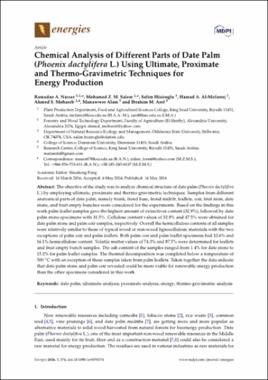| dc.contributor.author | Nasser, Ramadan A. | |
| dc.contributor.author | Salem, Mohamed Z. M. | |
| dc.contributor.author | Hiziroglu, Salim | |
| dc.contributor.author | Al-Mefarrej, Hamad A. | |
| dc.contributor.author | Mohareb, Ahmed S. | |
| dc.contributor.author | Alam, Manawwer | |
| dc.contributor.author | Aref, Ibrahim M. | |
| dc.date.accessioned | 2019-08-22T17:50:55Z | |
| dc.date.available | 2019-08-22T17:50:55Z | |
| dc.date.issued | 2016-05-16 | |
| dc.identifier | oksd_nasser_chemicalanalys_2016 | |
| dc.identifier.citation | Nasser, R. A., Salem, M. Z. M., Hiziroglu, S., Al-Mefarrej, H. A., Mohareb, A. S., Alam, M., & Aref, I. M. (2016). Chemical analysis of different parts of date palm (Phoenix dactylifera L.) using ultimate, proximate and thermo-gravimetric techniques for energy production. Energies, 9(12). https://doi.org/10.3390/en9050374 | |
| dc.identifier.uri | https://hdl.handle.net/11244/321246 | |
| dc.description.abstract | The objective of the study was to analyze chemical structure of date palm ( Phoenix dactylifera L.) by employing ultimate, proximate and thermo-gravimetric techniques. Samples from different anatomical parts of date palm, namely trunk, frond base, frond midrib, leaflets, coir, fruit stem, date stone, and fruit empty bunches were considered for the experiments. Based on the findings in this work palm leaflet samples gave the highest amount of extractives content (32.9%), followed by date palm stone specimens with 31.5%. Cellulose content values of 32.8% and 47.5% were obtained for date palm stone and palm coir samples, respectively. Overall the hemicellulose contents of all samples were relatively similar to those of typical wood or non-wood lignocellulosic materials with the two exceptions of palm coir and palm leaflets. Both palm coir and palm leaflet specimens had 12.6% and 16.1% hemicellulose content. Volatile matter values of 74.3% and 87.5% were determined for leaflets and fruit empty bunch samples. The ash content of the samples ranged from 1.4% for date stone to 15.2% for palm leaflet samples. The thermal decomposition was completed below a temperature of 500 °C with an exception of those samples taken from palm leaflets. Taken together the data indicate that date palm stone and palm coir revealed could be more viable for renewable energy production than the other specimens considered in this work. | |
| dc.format | application/pdf | |
| dc.language | en_US | |
| dc.publisher | MDPI | |
| dc.rights | This material has been previously published. In the Oklahoma State University Library's institutional repository this version is made available through the open access principles and the terms of agreement/consent between the author(s) and the publisher. The permission policy on the use, reproduction or distribution of the material falls under fair use for educational, scholarship, and research purposes. Contact Digital Resources and Discovery Services at lib-dls@okstate.edu or 405-744-9161 for further information. | |
| dc.title | Chemical analysis of different parts of date palm (Phoenix dactylifera L.) using ultimate, proximate and thermo-gravimetric techniques for energy production | |
| osu.filename | oksd_nasser_chemicalanalys_2016.pdf | |
| dc.description.peerreview | Peer reviewed | |
| dc.identifier.doi | 10.3390/en9050374 | |
| dc.description.department | Natural Resource Ecology and Management | |
| dc.type.genre | Article | |
| dc.type.material | Text | |
| dc.subject.keywords | date palm | |
| dc.subject.keywords | ultamiate analysis | |
| dc.subject.keywords | proximate analysis | |
| dc.subject.keywords | energy | |
| dc.subject.keywords | thermo-gravimatric analysis | |
